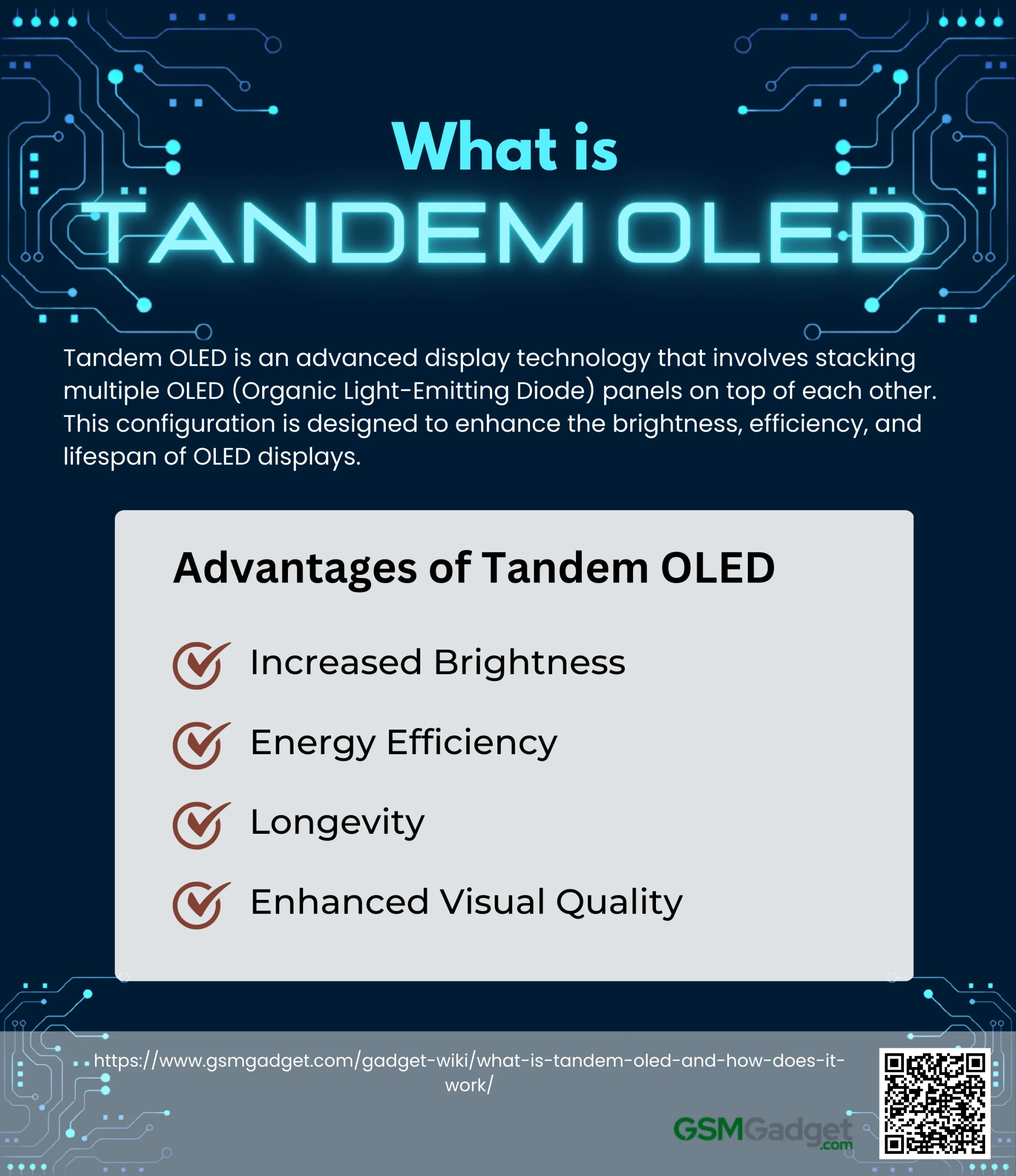Tandem OLED is an advanced display technology that involves stacking multiple OLED (Organic Light-Emitting Diode) panels on top of each other. This configuration is designed to enhance the brightness, efficiency, and lifespan of OLED displays.
Tandem OLED is an innovative evolution in OLED technology that addresses some of the limitations of traditional OLED displays, particularly in terms of brightness and longevity. Tandem OLED technology involves stacking two layers of OLED pixels on top of each other. Each layer has its own set of red, green, and blue subpixels, which work together to produce light more efficiently and brightly than a single layer could work.
By combining the light output of two OLED layers, Tandem OLED displays achieve significantly higher brightness levels. This is particularly beneficial for devices used in bright environments, such as smartphones and tablets. For example, the new iPad Pro with Tandem OLED technology can reach up to 1,000 nits of full-screen brightness for SDR and HDR content, with peak HDR brightness hitting 1,600 nits.
Moreover, the dual-layer structure of Tandem OLEDs distributes the electrical load across two layers instead of one. This reduces the stress on the organic materials, thereby mitigating the risk of burn-in and extending the lifespan of the display. It also enhances energy efficiency, which can contribute to longer battery life for portable devices.
Origin of Tandem OLED Technology
Tandem OLED technology was first developed by LG Display in 2019, initially aimed at enhancing automotive displays. This innovative approach was designed to meet the high durability and brightness standards required for in-vehicle displays, which need to operate reliably over extended periods and in various lighting conditions. By stacking two layers of organic light-emitting diodes (OLEDs), Tandem OLED technology provides superior brightness and longevity compared to traditional single-layer OLEDs.
The primary motivation behind this development was to create more durable and longer-lasting heads-up displays for vehicles. These displays needed to withstand the rigors of automotive environments while maintaining high performance. The dual-layer structure of Tandem OLEDs distributes the electrical load more evenly, reducing the stress on the organic materials and thus extending the display’s lifespan. This innovation marked a significant milestone in OLED technology, setting the stage for its application in other high-performance devices like laptops and tablets.
LG Display’s pioneering work in Tandem OLED technology has since expanded beyond automotive applications. The company has begun mass production of Tandem OLED panels for laptops, offering benefits such as higher brightness, longer lifespan, and reduced power consumption. These advancements make Tandem OLED an attractive option for various consumer electronics, promising enhanced performance and durability.
How Does Tandem OLED Work?
Structure
Tandem OLED technology involves stacking two or more OLED panels on top of each other. Unlike traditional OLED displays, which consist of a single layer of organic light-emitting diodes, tandem OLEDs utilize multiple layers. Each layer in a tandem OLED emits light independently, and the combined output results in a much brighter display. This structure not only boosts brightness but also spreads the electrical load across multiple layers, reducing the strain on each individual layer and enhancing the overall durability of the display.
Mechanism
The core mechanism of tandem OLED technology lies in the self-emissive nature of OLED pixels. Each pixel generates its own light when electricity passes through it, unlike LCD screens that rely on a backlight. By stacking multiple OLED layers, the light output is significantly increased. This means that tandem OLED displays can achieve higher brightness levels without compromising on the quality of the image or the lifespan of the screen. The tandem structure also helps in reducing power consumption and mitigating issues like screen burn-in by distributing the workload more evenly across the layers.
Advantages of Tandem OLED

Tandem OLED technology represents a significant advancement in the realm of display screens. By stacking multiple OLED layers on top of each other, tandem OLEDs achieve higher brightness levels, improved efficiency, and enhanced longevity compared to traditional OLEDs. This innovative approach not only addresses the common issue of insufficient brightness in OLED screens but also reduces the risk of burn-in, making the displays more durable. Additionally, tandem OLEDs maintain the superior contrast, perfect blacks, and vibrant colors characteristic of OLED technology, while offering better energy efficiency and extended lifespan.
1. Increased Brightness:
Tandem OLED displays achieve higher brightness levels compared to single-layer OLEDs. For instance, the iPad Pro’s Tandem OLED can reach 1,000 nits for full-screen brightness and 1,600 nits for peak HDR brightness, making it ideal for use in various lighting conditions, from dimly lit rooms to bright outdoor environments.
2. Energy Efficiency:
One of the standout features of tandem OLED technology is its improved power efficiency. By distributing the workload across two layers, tandem OLEDs can reduce energy consumption by up to 40%, making them more environmentally friendly and extending the battery life of devices.
3. Longevity:
Tandem OLED displays have an extended lifespan due to reduced wear on each layer. This design makes them less susceptible to burn-in, a common issue with traditional OLED screens where static images can leave a permanent mark. The increased efficiency and reduced stress on each layer contribute to a longer-lasting display.
4. Enhanced Visual Quality:
Tandem OLED technology offers better color accuracy and contrast, providing a more vivid and immersive viewing experience. The higher brightness levels also improve visibility in bright environments and enhance the detail in dark scenes, making it perfect for HDR content and professional applications.
Applications of Tandem OLED
Tandem OLED technology is being adopted across various industries, enhancing the performance and durability of displays in multiple applications.
1. Consumer Electronics
- Tablets: Apple’s iPad Pro is a notable example, utilizing Tandem OLED for its Ultra Retina XDR display. This technology allows the iPad Pro to achieve impressive brightness levels of up to 1,000 nits for full-screen content and 1,600 nits for peak HDR content.
- Laptops and Smartphones: Future applications in laptops and smartphones are anticipated, offering brighter screens and longer battery life.
2. Automotive Displays
- Heads-Up Displays: Initially developed by LG Display for automotive use, Tandem OLED technology ensures that heads-up displays in cars are durable and maintain their brightness over the vehicle’s lifespan.
3. Televisions
- OLED TVs: Tandem OLED has the potential to enhance OLED TVs by bridging the brightness gap with LED TVs. This technology could lead to brighter and more efficient OLED TVs, making them more competitive in the market.
4. Industrial Use
- Medical Equipment: Tandem OLED displays can be used in medical equipment, where high brightness and longevity are crucial.
- Signage: The increased brightness and durability of Tandem OLED make it suitable for digital signage, which requires reliable and long-lasting displays.
Challenges and Downsides
Challenges and Downsides
- Higher Production Costs: The complexity of stacking multiple OLED layers increases manufacturing costs. This is reflected in the higher price of devices featuring Tandem OLED technology. For instance, the latest iPad Pro models are significantly more expensive than their predecessors.
- Increased Device Prices: Consumers can expect to pay a premium for devices with Tandem OLED displays. The 11-inch iPad Pro starts at $999, while the 13-inch model starts at $1299, which is notably higher than previous versions.
- Uniformity and Quality: Ensuring uniform brightness and color quality across the stacked layers can be challenging. Any inconsistencies can affect the overall display performance.
- Heat Dissipation and Power Consumption: Managing the heat generated by the stacked layers and ensuring efficient power consumption are critical to maintaining performance and longevity. These challenges require sophisticated engineering solutions to prevent overheating and excessive battery drain.
Comparison with Other Display Technologies
Standard OLED vs. Tandem OLED
- Brightness: Tandem OLED displays are significantly brighter than standard OLED displays due to the stacked layers.
- Efficiency: Tandem OLEDs are more efficient, reducing energy consumption and increasing the display’s lifespan.
- Burn-in Resistance: Tandem OLEDs distribute the workload across two layers, reducing the risk of burn-in compared to standard OLEDs.
Pros of Tandem OLED:
- Increased brightness and efficiency
- Reduced risk of burn-in
- Longer lifespan
Cons of Tandem OLED:
- Higher cost due to the complexity of manufacturing
LCD vs. Tandem OLED
- Brightness: Tandem OLEDs can achieve higher brightness levels than traditional LCDs.
- Contrast Ratio: OLEDs, including tandem OLEDs, offer superior contrast ratios with true blacks, as each pixel emits its own light.
- Power Efficiency: Tandem OLEDs are more power-efficient than LCDs, as they do not require a backlight and distribute the electrical load across multiple layers.
Pros of Tandem OLED:
- Superior brightness and contrast
- Higher power efficiency
- Better viewing angles and color accuracy
- Faster response times
Cons of Tandem OLED:
- Higher cost
- Potential for burn-in, though reduced compared to standard OLEDs
